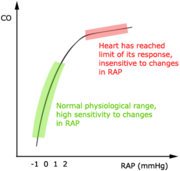
Cardiac function curve
Encyclopedia

Central venous pressure
Central venous pressure describes the pressure of blood in the thoracic vena cava, near the right atrium of the heart...
(x-axis) and cardiac output
Cardiac output
Cardiac output is the volume of blood being pumped by the heart, in particular by a left or right ventricle in the time interval of one minute. CO may be measured in many ways, for example dm3/min...
(y-axis).
Superimposition of the cardiac function curve and venous return curve is used in one hemodynamic model.
Shape of curve
It shows a steep relationship at relatively low filling pressures and a plateau, where further stretch is not possible and so increases in pressure have little effect on output. The pressures where there is a steep relationship lie within the normal range of right atrial pressure (RAP) found in the healthy human during life. This range is about -1 to +2 mmHgTorr
The torr is a non-SI unit of pressure with the ratio of 760 to 1 standard atmosphere, chosen to be roughly equal to the fluid pressure exerted by a millimetre of mercury, i.e., a pressure of 1 torr is approximately equal to 1 mmHg...
. The higher pressures normally occur only in disease
Disease
A disease is an abnormal condition affecting the body of an organism. It is often construed to be a medical condition associated with specific symptoms and signs. It may be caused by external factors, such as infectious disease, or it may be caused by internal dysfunctions, such as autoimmune...
, in conditions such as heart failure, where the heart is unable to pump forward all the blood returning to it and so the pressure builds up in the right atrium and the great veins. Swollen neck veins are often an indicator of this type of heart failure.
At low right atrial pressures this graph serves as a graphic demonstration of the Frank–Starling mechanism, that is as more blood is returned to the heart, more blood is pumped from it without extrinsic signals.
Changes in the cardiac function curve
In vivoIn vivo
In vivo is experimentation using a whole, living organism as opposed to a partial or dead organism, or an in vitro controlled environment. Animal testing and clinical trials are two forms of in vivo research...
however, extrinsic factors such as an increase in activity of the sympathetic nerves
Autonomic nervous system
The autonomic nervous system is the part of the peripheral nervous system that acts as a control system functioning largely below the level of consciousness, and controls visceral functions. The ANS affects heart rate, digestion, respiration rate, salivation, perspiration, diameter of the pupils,...
, and a decrease in vagal tone
Vagus nerve
The vagus nerve , also called pneumogastric nerve or cranial nerve X, is the tenth of twelve paired cranial nerves...
cause the heart to beat more frequently and more forcefully. This alters the cardiac function curve, shifting it upwards. This allows the heart to cope with the required cardiac output at a relatively low right atrial pressure. We get what is known as a family of cardiac function curves, as the heart rate increases before the plateau is reached, and without the RAP having to rise dramatically to stretch the heart more and get the Starling effect.
In vivo sympathetic
Sympathetic nervous system
The sympathetic nervous system is one of the three parts of the autonomic nervous system, along with the enteric and parasympathetic systems. Its general action is to mobilize the body's nervous system fight-or-flight response...
outflow
Outflow
Outflow may refer to:*Capital outflow - an economic term describing capital flowing out of a particular economy.*Bipolar outflow in astronomy represents two continuous flows of gas from the poles of a star....
within the myocardium is probably best described by the time honored description of the sinoatrial tree branching out to Purkinges fibers. Parasympathetic inflow
Inflow
Inflow may refer to:*Inflow - In hydrology, the source of the water in a body of water*Infiltration/Inflow, inappropriate connection of surface runoff drains into sanitary sewers*Inflow , air that flows inwards to a thunderstorm...
within the myocardium is probably best described by influence of the vagus nerve
Vagus nerve
The vagus nerve , also called pneumogastric nerve or cranial nerve X, is the tenth of twelve paired cranial nerves...
and spinal accessory ganglia.

